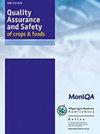Dissipation, residues analysis and risk assessment of metconazole in grapes under field conditions using gas chromatography–tandem mass spectrometry
IF 5.3
3区 农林科学
Q1 FOOD SCIENCE & TECHNOLOGY
引用次数: 15
Abstract
Metconazole (MEZ) is widely used in prevention and control of fruit and vegetable diseases. Here, a simple and reliable gas chromatography–tandem mass spectrometry (GC-MS/MS) method, using modified QuEChERS (“quick, easy, cheap, effective, rugged and safe”) extraction method, was developed for determining the dissipation and residue of MEZ in grapes and soil, and the dietary risk of MEZ residues in grapes was evaluated for Chinese people. The average recoveries of MEZ in two matrices were 80.72–100.36% with relative standard deviations of 1.56–6.16%. The same limits of detection and quantification in grapes and soil were 0.0006 mg/kg and 0.002 mg/kg, respectively. Under field conditions, the half-life of MEZ dissipation in grapes ranged from 11.75 to 20.39 days. The final residues of MEZ in grapes and soil ranged from 0.002 mg/kg to 0.19 mg/kg at pre-harvest intervals of 7, 14 and 21 days. The whole dietary risk assessment indicated acute hazard index and hazard quotient to be less than 1, implying the risk of MEZ was acceptable. This is the first study conducted on the dissipation, residue analysis and risk assessment of MEZ in grapes, thus providing reference for the detection and risk assessment of MEZ in other agricultural products.用气相色谱-串联质谱法分析葡萄中甲基康唑的耗散、残留及风险评价
甲康唑(MEZ)广泛应用于果蔬病害的防治。本文采用改进的QuEChERS(快速、简便、廉价、有效、坚固、安全)提取方法,建立了一种简便、可靠的气相色谱-串联质谱(GC-MS/MS)测定MEZ在葡萄和土壤中的耗散和残留的方法,并对国人葡萄中MEZ残留的膳食风险进行了评价。两种基质中MEZ的平均回收率为80.72 ~ 100.36%,相对标准偏差为1.56 ~ 6.16%。葡萄和土壤的检出定量限分别为0.0006 mg/kg和0.002 mg/kg。在田间条件下,葡萄MEZ耗散半衰期为11.75 ~ 20.39 d。收获前7、14和21 d, MEZ在葡萄和土壤中的最终残留量为0.002 ~ 0.19 mg/kg。整体膳食风险评估急性危害指数和危害商均小于1,MEZ风险可接受。本文首次开展了MEZ在葡萄中的耗散、残留分析和风险评价研究,为其他农产品中MEZ的检测和风险评价提供参考。
本文章由计算机程序翻译,如有差异,请以英文原文为准。
求助全文
约1分钟内获得全文
求助全文
来源期刊

Quality Assurance and Safety of Crops & Foods
FOOD SCIENCE & TECHNOLOGY-
CiteScore
4.60
自引率
7.50%
发文量
61
审稿时长
1 months
期刊介绍:
''Quality Assurance and Safety of Crops & Foods'' is an international peer-reviewed journal publishing research and review papers associated with the quality and safety of food and food sources including cereals, grains, oilseeds, fruits, root crops and animal sources. It targets both primary materials and their conversion to human foods. There is a strong focus on the development and application of new analytical tools and their potential for quality assessment, assurance, control and safety. The scope includes issues of risk assessment, traceability, authenticity, food security and socio-economic impacts. Manuscripts presenting novel data and information that are likely to significantly contribute to scientific knowledge in areas of food quality and safety will be considered.
''Quality Assurance and Safety of Crops & Foods'' provides a forum for all those working in the specialist field of food quality and safety to report on the progress and outcomes of their research.
 求助内容:
求助内容: 应助结果提醒方式:
应助结果提醒方式:


